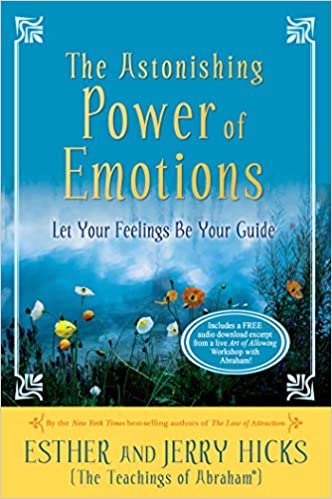This is a summary of The Astonishing Power of Emotions: Let your feelings be your guide by Esther and Jerry Hicks (The teachings of Abraham).
Prior to birth, your nonphysical being had an eager thought to be physical and this was realized. There were no concerns about the ability to handle it or change the world just a desire for direct experience. This expansion resulted in a nonphysical viewpoint as well as a new physical viewpoint.
The ‘physical you’ experience provides the contrast that allows you to gain clarity about what you do not want which can be turned into a desire for what you do want. This is leading-edge creativity. As soon as a desire occurs it is in the process of being created. This means that the variety of human experiences allows for expansion and improvement.
Emotions are the key to making these desires a reality. Each emotion indicates the vibrational relationship between the physical and nonphysical you. When they are aligned you feel good and when they are not aligned you feel bad.
Emotional alignment allows you to keep up with what you are becoming and live joyfully.
Upstream or Downstream emotions?
Emotions provide the necessary prompt to align thought energies and focus your attention in the direction of your desire. A bad emotion (struggling to go upstream) means that you are out of harmony. A good emotion means going with the flow downstream. Nothing that you want is downstream.
The ‘nonphysical you’ becomes vibrationally equivalent to each desire from the ‘physical you’. Therefore, think about the gap between where you are now and what you desire in terms of the vibration needed rather than the action needed. Concepts such as trying harder, working longer, or focusing better are upstream as they usually create urgency and consequently constrictive emotions rather than heartfelt joy.
Three universal laws
Three laws are under consideration here, but the one that describes managing your emotions is the third.
- Law of Attraction: Your physical experience matches your vibration. You do not have to do anything to prompt this.
- Law of Deliberate Creation: You can deliberately direct your attention and thoughts towards the outcomes that you desire.
- Law of Allowing: Flowing downstream to align with who you are is supported by letting it be as it arises while gently directing your thoughts in the direction you desire.
The Law of Allowing underpins emotional alignment.
Your emotion tells you the vibrational difference between the point of desire and the current thought, belief, or expectation. You can improve emotions gradually rather than jumping from extremely bad to extremely good.
In the second part of the book, Abraham provides many examples of applying the power of emotions.
Desires on health
If you take health you might have thoughts about a frightening personal diagnosis, or concern for your weight. You need to shift thoughts to allowing wellness and the body that is coming and the joy that this would bring.
Desires on relationships
Relationships might be impacted by tensions from another person’s fighting, disagreements, disrespect, lying, gossiping, death, divorce, or illness. In all of these instances, choose thoughts that allow you to make peace with what you can’t control and let go of being responsible for their happiness or changing their behavior. Move away from upstream thoughts that engage in struggle. Change your perspective to the gifts for those involved while trusting that they will be received in due course. Think about your resilience and opportunities to shift into the present and let go of regrets for what has been or fears for what could be.
Desires circumstances
Environmental circumstances could be things like being disorganized, being told what to do, not having money, not being able to find a partner, being stuck in traffic, or not being appreciated. This is an opportunity to engage with diversity and think about all the good things that these experiences allow. Also redirect your focus to the opposite where you have organization, abundance, peace, and gratitude. You are the creator here so focus on what you want, your achievement and receiving, without pressure for an immediate outcome.
For coaches, this book has a clear point of focus on what you can control – your own emotions, thoughts, and actions. There is great potential for insight here when a client refers to aspects outside of themselves which they cannot control. It also gives coaches a framework for asking questions that shift a client’s thinking and emotions downstream. This means coaching conversations can be focussed on finding the gifts and positive aspects and possibilities of any challenging circumstances. Another important shift in awareness is being ok with putting your own thoughts and feelings first and embracing behaviors that may be otherwise avoided as selfish.
Check out my Self Alignment Program to learn more about up-leveling your own use of the Law of Attraction.

